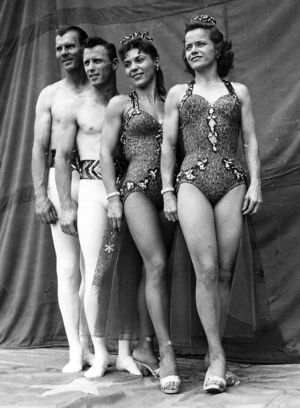Reggie Armor
From Circopedia
Aerialist
By Dominique Jando
Reggie Armor (1929-2010) was one of the great flyers of the 1960s and 1970s, a triple somersaulter at a time when only a few flying trapezeAerial act in which an acrobat is propelled from a trapeze to a catcher, or to another trapeze. (See also: Short-distance Flying Trapeze) artists were able to master the triple somersault from the fly-barOn a flying trapeze rig, the swinging trapeze used by the flyer (as opposed to the trapeze used by the catcher). to the catcherIn an acrobatic or a flying act, the person whose role is to catch acrobats that have been propelled in the air.. He later created an aerial thrill actA spectacular act that focuses on the display of danger, whether real or staged., which he performed until his retirement in 1978, due to an accident during a show.
Reginald C. Armor was born October 25, 1929 in Los Angeles, California, to a family that had no connection with the circus world. In his teens, young Reggie learned acrobatics on the famous "Muscle Beach" at Santa Monica, California and decided to make a living as an acrobat. He first joined the Dewayne Troupe, with which he worked in both a teeterboardA seesaw made of wood, or fiberglass poles tied together, which is used to propel acrobats in the air. act and a risley act, and then participated in a few other acrobatic acts.
But Armor had an ambition: to become a flyerAn acrobat that is propelled in the air, either in a flying act, or in an acrobatic act (i.e. teeterboard)., like his role model, the great triple-somersaulter Fay Alexander. Reggie eventually made his debut on the flying trapezeAerial act in which an acrobat is propelled from a trapeze to a catcher, or to another trapeze. (See also: Short-distance Flying Trapeze) in 1954, as age twenty-five—which was rather late—and teamed up with Muscle Beach fellow alumnus Bob Yerkes in an act that became known as the Flying Artons.
The act was composed of Bob Yerkes, who was the catcherIn an acrobatic or a flying act, the person whose role is to catch acrobats that have been propelled in the air., his wife, Dorothy, and Reggie and his wife, Bonnie, née Cristiani—a member of the famous Italian family of equestrians, whom he had met on Muscle Beach in the early 1950s. Between circus contracts, Bob and Reggie performed movie stunts in Hollywood; Reggie appeared notably in Michael Todd’s award-winning movie, Around The World In Eighty Days (1956).
At five feet seven inches (1.72 meters), Reggie was rather tall for a flyerAn acrobat that is propelled in the air, either in a flying act, or in an acrobatic act (i.e. teeterboard).; yet in 1962, Yerkes caught Reggie’s first triple—a trickAny specific exercise in a circus act. Reggie Armor would perform regularly with a success rate of more than 90%. In short order, The Flying Artons became a star act; Reggie was sometimes compared to the legendary Alfredo Codona, and he and his partners were featured in all major American circuses, and on television on ABC’s Hollywood Palace in 1956.The Flying Armors
After a long association, Bob Yerkes and Reggie Armor eventually parted ways, and Reggie continued with his own act, the Flying Armors, which included his daughter, SaSa Armor. The Flying Armors appeared in England, on Thames Television’s Hippodrome (1966), and are one of the acts featured in Gilbert Gates’s circus documentary, Rings Around The World (released in 1966).
When Reggie retired from flying, he and his daughter created an aerial thrill actA spectacular act that focuses on the display of danger, whether real or staged., with a rotating contraption that included a motorcycle Reggie rode on a small circular wooden platform up in the air. In 1978, while they were performing their act for the last time, outdoors at a church benefitSpecial performance whose entire profit went to a performer; the number of benefits a performer was offered (usually one, but sometimes more for a star performer during a long engagement) was stipulated in his contract. Benefits disappeared in the early twentieth century. fair, the carabiner holding Reggie's safety belt broke, and he fell sixty feet to the concrete walkway below. He was severely injured and had to undergo no less than six surgeries that kept him hospitalized for several months.
That was the end of Reggie Armor’s performing career. He continued to work in a circus management capacity and as an event promoter. Reggie and Bonnie eventually retired, and they left Sarasota, Florida, home of many circus families, to settle in Tulsa, Oklahoma. Reggie and Bonnie Armor had three children, Jay, SaSa and Reginald III. Jay, the oldest, worked as a clown in the trampoline act the family performed in addition to other acts; he was tragically killed in a random shooting in a bar on New Year's Eve 1975, at age 21.
Reggie Armor passed away in Tulsa on May 22, 2010. He was eighty years old.
See Also
- Video: The Flying Armors (c.1965) in Massachusetts.
- Video: The Flying Armors (1966) On Thames Television's Hippodrome.


